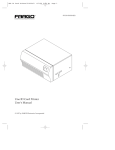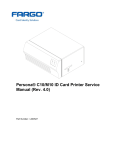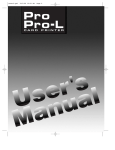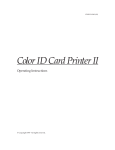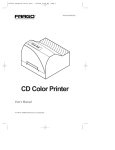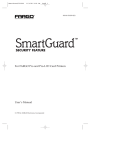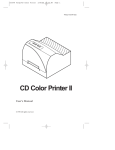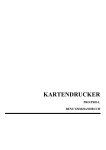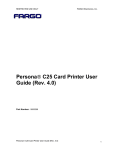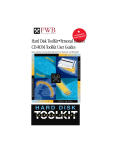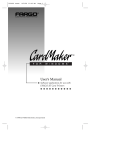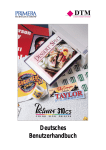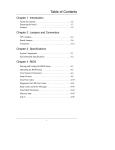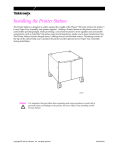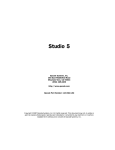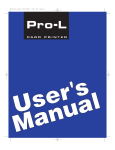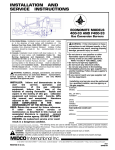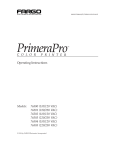Download FARGO electronic Quatro ID Card Printer User's Manual
Transcript
Quatro/510323 v3 1/8/99 10:48 AM Page i 981231-510323-(03) Quatro ID Card Printer UserÕs Manual Quatro/510323 v3 1/8/99 10:48 AM Page ii Notices The information in this document is subject to change without notice. NO WARRANTIES OF ANY KIND ARE MADE WITH REGARD TO THIS MATERIAL, INCLUDING, BUT NOT LIMITED TO, THE IMPLIED WARRANTIES OF MERCHANTABILITY AND FITNESS FOR A PARTICULAR PURPOSE. The manufacturer shall not be liable for errors contained herein or for incidental damages in connection with the furnishing, performance, or use of this material. This document contains proprietary information which is protected by copyright. All rights are reserved. No part of this document may be photocopied, reproduced, or translated into another language without the prior written consent of the printer manufacturer. Patent Pending Trademark Acknowledgments Windows and Microsoft are registered trademarks of Microsoft Corporation. All other trademarks are the property of their respective owners. Printing History Edition 1.3, #981231 © Copyright 1997 All rights reserved. For Users in the United States: This equipment has been tested and found to comply with the limits for a Class A digital device, pursuant to Part 15 of the FCC Rules. These limits are designed to provide reasonable protection against harmful interference in a residential installation. This equipment generates, uses, and can radiate radio frequency energy and, if not installed and used in accordance with the instructions, may cause harmful interference to radio communications. However, there is no guarantee that interference will not occur in a particular installation. If this equipment does cause harmful interference to radio or television reception, which can be determined by turning the equipment off and on, the user is encouraged to try to correct the interference by one or more of the following measures: ¥ Re-orient or relocate the receiving antenna. ¥ Increase the separation between the equipment and receiver. ¥ Connect the equipment into an outlet on a circuit different from that to which the receiver is connected. ¥ Consult the dealer or an experienced radio/TV technician for help. ¥ Use of a shielded cable is required to comply with the Class A limits of Part 15 of the FCC Rules. ¥ You are cautioned that any changes or modifications not expressly approved in this manual could void your authority to operate and/or obtain warranty service for this equipment. For Users in Canada: This digital apparatus does not exceed the Class A limits for radio noise for digital apparatus set out on the Radio Interference Regulations of the Canadian Department of Communications. Le present appareil numerique nÕemet pas de bruits radioelectriques depassant les limites applicables aux appareils numeriques de la class A prescrites dans le Reglement sur le brouillage radioelectrique edicte par le ministere des Communications du Canada. CAUTION! TO PREVENT FIRE OR SHOCK HAZARD, DO NOT EXPOSE THE UNIT TO RAIN OR MOISTURE. TO REDUCE THE RISK OF ELECTRIC SHOCK, DO NOT REMOVE EXTERIOR PANELS. NO USER-SERVICEABLE PARTS INSIDE. REFER SERVICING TO QUALIFIED SERVICE PERSONNEL. OPERATE THE UNIT ONLY ON 110-120 VAC, 50/60 Hz. FOR PRINTERS THAT HAVE BEEN SHIPPED OUTSIDE OF THE UNITED STATES AND CANADA, OPERATE THE UNIT ONLY ON 220-240 VAC, 50/60 Hz. USE PRINTER ONLY WITH THE INCLUDED POWER SUPPLY. ii Quatro/510323 v3 1/8/99 10:48 AM Page iii Table of Contents Chapter 1: Getting Started I. Choosing a Good Location ..........................................................1 II. About Moisture Condensation....................................................1 III. Unpacking and Inspection ...........................................................2 Chapter 2: Powering Up the Printer I. Applying Power ............................................................................3 II. Identifying the Printer Features ..................................................5 Chapter 3: Ribbons and Cards I. About Ribbons ...............................................................................6 II. Loading Ribbon into the Printer .................................................7 III. About Cards .................................................................................10 IV. Loading Cards into the Printer .................................................10 V. Printing a Self Test.......................................................................12 Chapter 4: Using the Quatro ID Card Printer I. Connecting the Printer to your Computer ..............................13 II. Installing the Windows Printer Driver ....................................14 III. Installing the 32-Bit Print Spooler for Windows 95/98 .........16 IV. Setting up the Windows Printer Driver...................................18 V. Printing a Card ............................................................................26 Chapter 5: Maintenance I. Supplies Required .......................................................................27 II. Standard Printhead Cleaning ....................................................28 III. Expanded Printhead Cleaning ..................................................29 IV. Cleaning the PrinterÕs Case .......................................................29 V. Cleaning the Inside of the Printer.............................................30 VI. Clearing a Card Jam....................................................................30 VII. Clearing a Ribbon Jam................................................................31 VIII. Cleaning the Card Feed Rollers ................................................31 IX. Cleaning the Drive Roller ..........................................................33 X. Maintaining the Cleaning Rollers .............................................33 Chapter 6: Troubleshooting..........................................................................35 Chapter 7: Technical Specifications............................................................41 iii Quatro/510323 v3 1/8/99 10:48 AM Page iv Appendix A: Magnetic Stripe Encoding Module I. Magnetic Track Options .............................................................42 II. Track Locations ............................................................................45 III. Sending Track Information ........................................................45 Appendix B: Interfacing Information I. Introduction..................................................................................47 II. Centronics-Type Parallel Interface............................................47 Index .................................................................................................................48 iv Quatro/510323 v3 1/8/99 10:48 AM Page 1 Chapter 1: Getting Started THANK YOU... ...for choosing the Quatro ID Card Printer. This fast, compact printer has been designed to print high-quality, full-color ID cards from virtually any Windows¨ application program. It offers many features which easily allow you to create durable photo ID cards complete with high resolution graphics, text, bar codes, and more. To begin using Quatro, please refer to the remainder of this manual. The Quatro UserÕs Manual is your complete step-bystep guide to efficiently setting up and printing with your new Quatro ID Card Printer. I. CHOOSING A GOOD LOCATION ¥ ¥ ¥ Place unit in a location with adequate air circulation to prevent internal heat build up. Do not place unit near heat sources such as radiators or air ducts or in a place subject to direct sun-light, excessive dust, mechanical vibration or shock. Allow for adequate clearance above the unit to accommodate the height of the unit with its Top Cover and Printhead Assembly open. II. ABOUT MOISTURE CONDENSATION If the unit is brought directly from a cold to a warm location, or is placed in a very damp room, moisture may condense inside the unit. Should this occur, print quality may not be optimum. Leave the unit turned OFF in a warm, dry room for several hours before using. This will allow the moisture to evaporate. Getting Started 1 Quatro/510323 v3 1/8/99 10:48 AM Page 2 III. UNPACKING AND INSPECTION While unpacking your Quatro ID Card Printer, inspect the carton to ensure that no damage occurred during shipping. Also, make sure the following items are included: ¥ ¥ ¥ ¥ ¥ ¥ ¥ Printer Power Transformer Attachable Card Output Hopper Printer Driver Software 32-Bit Print Spooler Software Warranty Statement and Registration Card This manual and other printed information 2 Getting Started Quatro/510323 v3 1/8/99 10:48 AM Page 3 Chapter 2: Powering Up the Printer I. APPLYING POWER 1. Locate the ÒDesk-Top TransformerÓ supplied with your system. Check that it is properly configured for the power used in your country. OP DESK-T MER FOR TRANS CAUTION! IF YOU HAVE ANY DOUBTS ABOUT THE PLUG CONFIGURATION OR THE VOLTAGE, DO NOT ATTEMPT TO USE THE PRINTER. CONTACT YOUR AUTHORIZED QUATRO RESELLER FOR INFORMATION ON THE CORRECT TRANSFORMER. USE YOUR PRINTER ONLY IF YOU ARE CERTAIN THAT THE PLUG AND POWER RATING ARE CORRECT. ! THE QUATRO TRANSFORMER IS DESIGNED FOR DESKTOP USE ONLY. Powering Up the Printer 3 Quatro/510323 v3 2. 1/8/99 10:48 AM Page 4 Plug the DC power plug end of the transformer cord into the Power Input Port on the rear panel of Quatro. Power Input Port NOTE: Optional external transformer must be a Listed Class 2 device with an output rating of 16.5 volts and 3.5 amps AC (alternating current). The alternating current should be between 50 and 60 Hz. 3. Plug the AC power plug end of the transformer cord into an available wall outlet. The wall outlet should be located near the printer and should be easily accessible. Power is automatically applied to the printer when it is plugged in. Press the on/cancel button if you wish to turn the printer OFF. 4 Powering Up the Printer Quatro/510323 v3 1/8/99 11:06 AM Page 5 II. IDENTIFYING THE PRINTER FEATURES This illustration shows the features found on the front of your Quatro ID Card Printer. On/Cancel Button On-Line Button Top Cover Card Output Hopper On/Cancel LED Light On-Line LED Light Card Input Hopper The on/cancel button turns the printer ON and OFF. It also serves to cancel the current print job and reset the printer for the next print job. If a card is left within the printer after a print job is canceled, it will automatically be ejected when the printer is turned back ON. The on-line button takes the printer on and off-line. The printer must have the on-line light illuminated in order to print. When flashing, the on-line light also serves to indicate a print error condition. Such conditions are discussed in Chapter 6 of this manual. The Card Input Hopper is where blank cards are loaded. See Chapter 3, Section IV for complete instructions on loading cards. The Card Output Hopper is where printed cards eject. An Attachable Card Output Hopper is included with your printer and serves to catch cards once they have finished printing. To attach this hopper, simply open the Top Cover of the printer and slip it over the edge of the printerÕs baseplate. Once the Top Cover is closed, it will hold the hopper securely in place. The Top Cover tilts from front-to-back to open and is how you access the inside of the printer to load cards and ribbon. See Chapter 3 for an illustration of how this cover opens as well as for instructions on loading print supplies. Note that the Top Cover must be shut in order for Quatro to print. Powering Up the Printer 5 Quatro/510323 v3 1/8/99 10:48 AM Page 6 Chapter 3: Ribbons and Cards I. ABOUT RIBBONS The Quatro ID Card printer has the following ribbon types available for printing: ¥ Standard Resin Black (K) ribbon with no clear overlay panel (produces 1,000 prints) ¥ A variety of Colored Resin ribbons with no clear overlay panel (produce 1,000 prints) ¥ Premium Resin Black (K) ribbon with no clear overlay panel (produces 1,000 prints) ¥ A gold Metallic Resin ribbon with no clear overlay panel (produces 1,000 prints) ¥ Dye-Sublimation Black (BO) ribbon with a clear overlay panel (produces 500 prints) ¥ Full-Color (YMCBO) ribbon with a dye-sublimation black panel and a clear overlay panel (produces 250 prints) ¥ Full-Color (YMCKO) ribbon with a resin black panel and a clear overlay panel (produces 250 prints) The ribbons which have a clear overlay panel will print an ID card and place a clear, protective overlay over the cardÕs printable area. All color or monochrome dye-sublimation cards must have this overlay applied to them. If it is not applied, your cardÕs dye-sublimation image will quickly begin to wear or fade. Be sure the Overlay option within the printer driver setup window is selected when printing with ribbons which have a clear overlay panel. See Chapter 4, Section IV for instructions on enabling or disabling the printerÕs Overlay option. NOTE: The only time you should not utilize a ribbonÕs clear overlay panel is if you intend to apply a separate, custom overlaminate to a card immediately after printing. The ribbons which utilize a resin black, are intended for printing bar codes onto cards which can be read by both infrared and visible light bar code scanners. Bar codes printed with a dye-sublimation black can only be read by a visible light bar code scanner. Cards printed solely with monochrome resin text, bar codes, or images do not require any type of protective overlay. 6 Ribbons and Cards Quatro/510323 v3 1/8/99 10:48 AM Page 7 The black monochrome resin ribbons are available in both a premium and standard quality. The premium resin black ribbon provides maximum durability and is ideal for applications such as access control where cards are repeatedly swiped through a magnetic stripe reader. The standard resin black ribbon provides high durability ideal for most general purpose ID card applications. In addition to a standard black resin ribbon, Quatro also provides several other standard resin ribbons in a variety of spot colors including blue, green, red, and metallic gold. All monochrome resin ribbons provide 1,000 prints. The blue, green, and metallic gold ribbons are capable of printing bar codes which can be read by visible light bar code scanners only. Bar codes printed with the red ribbon are NOT readable. Please note that Quatro requires specialized ribbons in order to function properly. To order additional ribbons, contact your authorized Quatro reseller. IMPORTANT! Watches, rings, bracelets, and other jewelry can damage the printhead if accidentally bumped against it. For best results, remove such items before installing or removing ribbons. II. LOADING RIBBON INTO THE PRINTER Follow these steps to load ribbon into the Printer: 1. Remove the ribbon from its packaging. Do not touch the colored portion of the ribbon. Oil or dirt from your hands can impair print quality. 2. The supply end of the ribbon is the side with the fresh, unused ribbon on it. The ribbon take-up is the other end. Note that the black plug in the supply ribbon core must be present in order for Quatro to print properly. Ribbons and Cards 7 Quatro/510323 v3 1/8/99 10:48 AM Page 8 3. Open the Top Cover of the printer by gently grasping the front sides of the cover and lifting upward. The cover will tilt open from front-to-back. 4. Open the Printhead Assembly by gently pulling up on the assemblyÕs Release Tab and lifting upward. Allow the assembly to swing completely open. Release Tab Printhead Assembly 5. Place the supply end of the ribbon in between the two black Ribbon Drive Hubs located on the right-hand side of the printerÕs interior. Make certain that the ribbon is fed from underneath the ribbon roll. HINT: The Ribbon Drive Hub nearest you, as you are looking into the printer from the front, is spring loaded. Use the end of the ribbon supply core to push in this Ribbon Drive Hub when inserting the ribbon. 8 Ribbons and Cards Quatro/510323 v3 1/8/99 10:48 AM Take-up Ribbon Drive Hubs Page 9 Supply Ribbon Drive Hubs Ribbon Sensor 6. Place the take-up end of the ribbon roll in between the two black Ribbon Drive Hubs located on the left-hand side of the printerÕs interior. Load the ribbon take-up end of the ribbon just as you loaded the ribbon supply end. When loaded properly, the ribbon should feed underneath both ends of the ribbon roll. Supply Roll Take-Up Roll Cleaning Roller Assembly 7. Grasp the Release Tab and gently lower the Printhead Assembly to close it. Lift slightly on the Release Tab to latch the assembly shut. Close the printerÕs Top Cover. When you start to print, the Ribbon Drive Hubs will automatically engage the notches on both cores of the ribbon roll. IMPORTANT! Do not reverse the ribbon. Damage may occur to the thermal printhead! Ribbons and Cards 9 Quatro/510323 v3 1/8/99 10:48 AM Page 10 III. ABOUT CARDS The Quatro ID Card Printer prints onto standard CR-80 size cards (3.375"L x 2.125"W x .030" / 86mmL x 54mmW x .75mm) which have a clean, level, polished PVC surface. Although Quatro is equipped with card cleaning rollers, it is very important to always print onto cards designed for direct-tocard, thermal printing. For this reason, a special card stock is available which is specifically designed for printing with Quatro. This card stock provides a level, polished PVC surface free of fingerprints, dust, and any other types of embedded contaminants. In addition, this card stock is packaged and shipped in dust-free plastic bags. To order compatible card stock, contact your authorized Quatro reseller. IMPORTANT! Never run cards with a contaminated, dull, or uneven surface through the printer. Printing onto such cards will ultimately lead to poor print quality and will greatly reduce the life of your printhead. In addition, always store your card stock in its original packaging or in a clean, dust-free environment. Do not print onto cards which have been dropped or soiled. Printheads damaged by contaminated or poor quality cards will automatically void the printheadÕs factory warranty. IV. LOADING CARDS INTO THE PRINTER Quatro holds a maximum of 50 CR-80 size cards in its Card Input Hopper. The printer will automatically feed each card off the top of the stack. To load the cards into the printer, refer to the following steps: 1. Open the Top Cover of the printer by gently grasping the front sides of the cover and lifting upward. The cover will tilt open from front-to-back. 10 Ribbons and Cards Quatro/510323 v3 1/8/99 10:48 AM Page 11 2. Remove a stack of 50 or fewer cards from the card packaging. Do not touch the area of the cards on which you intend to print. Oil or dirt from your hands can impair print quality. Handle cards only along the edges. 3. Load the stack of cards into the printer by depressing the spring loaded Card Input Tray and pushing the stack all the way to the front of the Card Input Hopper. Always load cards with the top or primary print side facing up. If inserting cards with a magnetic stripe, be sure the magnetic stripe is positioned downward and that the stripe is oriented toward the rear of the printer. If inserting smart cards, be sure the end of the card containing the smart card chip is inserted first. Card Stack Card Input Tray 4. Once the cards have been inserted, remove the top card and throw it away if you suspect it has been contaminated with oil from your fingertips. Close the printerÕs Top Cover. Ribbons and Cards 11 Quatro/510323 v3 1/8/99 10:48 AM Page 12 V. PRINTING A SELF TEST Now that ribbon and cards are installed, a self test should be performed to check for proper operation of the printer. The standard self test function requires only that a full-color ribbon and at least one card is installed. A sample of the self test pattern is shown below. If power is ON, turn it OFF now by pressing the on/cancel button. The LED indicator lights should no longer be illuminated. Verify that a full-color ribbon is installed and that cards are properly loaded. 2. Press and hold the on-line button. 3. While holding the on-line button down, turn the printer power back ON by quickly pressing and releasing the on/cancel button. 4. Release the on-line button. The gray scale self test pattern will begin printing approximately 10 seconds after the online button is released. v1.x.x 1. Self Test Example: (Actual size) 12 Ribbons and Cards Quatro/510323 v3 1/8/99 10:48 AM Page 13 Chapter 4: Using the Quatro ID Card Printer I. CONNECTING THE PRINTER TO YOUR COMPUTER The Quatro ID Card Printer is designed to be used with nearly any IBM-PC or compatible running Windows 3.1x, Windows 95/98, or Windows NT. A minimum of a 486 DX class computer with 4MB RAM or higher is required. For best performance, a Pentiumª class computer with 16 MB RAM or higher is recommended. The printer is equipped with an ECP-compatible, high-speed Centronics parallel port. This port is the means through which the printer receives data from your computer. To connect the printer to your computer, obtain a shielded, bi-directional parallel cable and refer to the following steps: 1. Connect the Centronics-type parallel side to the printer. Snap the fastening clips into place. 2. Connect the other side to the back of your PC at the PARALLEL connector. The printer must have its on-line light illuminated to receive data. If the light is not ON, press the on-line button. Using the Quatro ID Card Printer 13 Quatro/510323 v3 1/8/99 10:48 AM Page 14 II. INSTALLING THE WINDOWS PRINTER DRIVER The Quatro ID Card Printer can be used with virtually any Microsoft Windows 3.1x, Windows 95/98, or Windows NT software application program. Before printing, however, you must tell the application that youÕre using the Quatro ID Card Printer. This is accomplished the first time you use the printer by installing in Windows what is called a Òprinter driver.Ó The printer driver is simply a diskette with software on it that gives the printer the proper commands it needs in order to print. Separate printer driver diskettes are included and labeled for use with Windows (3.1x/95/98) or Windows NT. Install the appropriate printer driver for your system. After you have installed the driver, put the driver diskette in a safe place for possible future use. For details on all printer driver options, refer to Section IV of this chapter. NOTE: This section of the OperatorÕs Manual assumes that you are already familiar with Windows and know how it operates. If you are not yet familiar with Windows, consult the appropriate Microsoft documentation to become familiar with the basics of Windows before proceeding. Windows 95/98 or Windows NT: To install the printer driver into Windows 95/98 or Windows NT, refer to the following: 1. Insert the printer driver diskette into your computerÕs disk drive. 2. Click the Start button, point to Settings, and select Printers. 3. Double-click on the Add Printer icon. 14 Using the Quatro ID Card Printer Quatro/510323 v3 4. 1/8/99 10:48 AM Page 15 Follow the on-screen instructions to complete installation. When prompted, do not have Windows print a test print, since you most likely performed a printer self test in Chapter 3. Once installed, the ÒColor ID Card QuatroÓ printer icon will appear in the Printers folder. NOTE: Occasionally, new printer driver versions are released which have new or updated features. Before installing an updated printer driver version, always delete the existing printer driver version from your system. To do this, simply select the printer driver icon from within the Printers folder, and press the Delete key. A message may appear saying, ÒSome files were used only for this printer and are no longer needed. Would you like to delete these files now?Ó If you have FargoColor and/or the 32-Bit Print Spooler installed, select NO. If none of these applications apply, select YES. Windows 3.1x: To install the printer driver into Windows 3.1x, refer to the following: 1. After starting Windows, go to the Main program group and select Control Panel. 2. From the Control Panel, select Printers. 3. Select Use Print Manager from the bottom left of the Printers window. 4. Select the Add>> button. 5. Highlight the Install Unlisted or Updated Printer option from List of Printers. 6. Select the Install button. 7. Insert the supplied Printer Driver diskette into your computerÕs disk drive. If you insert the diskette in a drive other than the A: drive displayed in the Install Driver dialog box, you must change the drive designation. Select the OK button. 8. ÒColor ID Card QuatroÓ should now be listed in the Add Unlisted or Updated Printer dialog box. Select the OK button. Your PCÕs disk drive will now load the printer driver. Depending upon your computer, loading will take about 10 to 20 seconds. Using the Quatro ID Card Printer 15 Quatro/510323 v3 9. 1/8/99 10:48 AM Page 16 Select the Set As Default Printer button in the Printers window. The Quatro ID Card Printer has now been selected as your default (main) printer. If you wish to use another printer later, you must de-select Quatro and switch back to the other printerÕs driver. 10. Finally, select the Connect button. Check that the box called Fast Printing Direct to Port is selected. Although this option is not necessary, it helps optimize printer driver speed and performance. Select OK to exit the Connect window. Select Close to exit the Printers window. See Section IV for information on printer driver settings and options. III. INSTALLING THE 32-BIT PRINT SPOOLER FOR WINDOWS 95/98 Your Quatro ID Card Printer ships with a print utility program called the 32-Bit Print Spooler. This print spooler is for use only with Windows 95/98. Once installed, the print spooler is able to process your print jobs and send them to the printer at consistently faster speeds than if sending print jobs through the Windows print spooler. This is especially true if printing with an ECP compatible parallel port or if printing off a network. The 32-Bit Print Spooler is ideal for printing a large number of consecutive ID cards, for printing larger file formats (1 MB or more), or if printing on a somewhat slower computer. The 32-Bit Print Spooler installs just like any other standard Windows application program. To install the 32-Bit Print Spooler, refer to the following: 1. Insert the 32-Bit Print Spooler diskette into your computerÕs disk drive. 2. Click the Start button, point to Settings, and select Control Panel. 16 Using the Quatro ID Card Printer Quatro/510323 v3 1/8/99 10:48 AM Page 17 3. Double-click on the Add/Remove Programs icon. 4. Follow the on-screen instructions to complete installation. When installed, the 32-Bit Print Spooler will appear in the Programs group of the Start menu. NOTE: Before installing updated 32-Bit Print Spooler versions, always uninstall the existing print spooler version from your system. To do this, simply select 32-Bit Print Spooler from the list of programs in the Add/Remove Programs Properties window and click on the Add/Remove button. To print with the 32-Bit Print Spooler, you must select the Fast 32-bit Spooler option from within the printer driver setup window as described in Section III. When this option is selected, the print spooler will automatically open and close with the start and finish of each print job. NOTE: You can also manually open the 32-Bit Print Spooler simply by selecting its icon from the Programs group of the Start menu. When the 32-Bit Print Spooler is running, its icon will appear in the Windows Task Bar. During a print job, it is sometimes helpful to click on this icon to bring the 32-Bit Print Spooler status window to the foreground of your application. This window provides a number of details about the print jobs being sent to Quatro. Using the Quatro ID Card Printer 17 Quatro/510323 v3 1/8/99 10:48 AM Page 18 The Current Job tab tells you the name and size of the file printing, the progress of the overall print job, as well as the total number of copies left to print. It also provides buttons which allow you to pause or cancel the print job at any time during the printing process. The Settings tab tells you the port and printer to which you are printing and allows you to configure the timeout settings. In most instances, these settings will rarely need to be changed. This tab also provides two other options called Save last job for reprint and Direct to Port Mode. When the Save last job for reprint option is selected, the 32-Bit Print Spooler will automatically save the last print job you sent to the printer and allow you to instantly reprint the job without the delay of having to reprocess it. The print job will be saved in the spooler until another print job is sent and saved over it. If you do not wish to save the last print job for reprint, deselect this option. To print a saved job, simply select the Print button from the spoolerÕs Current Job tab. The Direct to Port Mode option is selected by default. In most instances, this option allows the spooler to send data to the printer at its optimum speed. If, however, you experience problems when printing with this option selected, simply deselect it and try your print job again. The Job Queue tab appears only when a print job is being sent to the printer. This tab tells you the name and status of each job in the queue and shows you the order in which the jobs will print if you have sent multiple jobs to the printer. A control button is also provided which allows you to delete every job listed in the queue. To delete the job currently being printed, simply select the Cancel Print button under the Current Job tab. IV. SETTING UP THE WINDOWS PRINTER DRIVER Once the appropriate printer driver has been installed, you will need to set the driver up with the proper print options. Although each of the included printer drivers displays the print options in a slightly different format, the basic options are the same. For this reason, this section lists and describes each of the printer driver options in alphabetical order, rather than displaying them in the order in which they appear within any one of the printer drivers. 18 Using the Quatro ID Card Printer Quatro/510323 v3 1/8/99 10:48 AM Page 19 To open the printer driver setup window, please refer to the following steps for your specific operating system: Windows 3.1x 1. Go to the Main program group and select Control Panel. 2. From the Control Panel, select Printers. 3. Select the Setup button. Windows 95/98 1. Click the Start button, point to Settings, and select Printers. 2. Click on the Quatro Card Printer icon with the right mouse button, and select Properties. 3. Click on the Details tab of the Properties window, and select the Setup button. Windows NT 1. Click the Start button, point to Settings, and select Printers. 2. Click on the Quatro Card Printer icon with the right mouse button, and select Document Defaults. 3. Click on the Advanced tab of the Document Settings window. NOTE: Most applications allow you to change these same printer driver options from their own Print screens. This means that you donÕt have to go back to the main printer setup window each time you want to change a setting or option in the printer driver. These applications will usually give you the same choices and options, but in a slightly altered format. To change or verify the appropriate printer driver options for your print job, please refer to the following descriptions given in alphabetical order: Card Size This option displays a list of the available card size selections. The Std CR-80 selection allows you to print and overlay the entire printable area of a standard CR-80 size card. The Smart Card, Magstripe, and Punch Offset selections allow you to print and overlay only within the given card areas. The Smart Chip selection allows you to print and overlay anywhere on a card except over the immediate location of a standard smart card chip. These selections prevent you from printing over or Using the Quatro ID Card Printer 19 Quatro/510323 v3 1/8/99 10:48 AM Page 20 damaging the area of the card containing the magnetic stripe, IC chip, or punched slot. Select the card size option thatÕs appropriate for the type of card you are using (see Chapter 3, Section III for important card stock information). Color Matching This feature allows you to select the appropriate color matching option. Select None if you are more interested in print speed rather than print color, if you have already color corrected your image for printing, or if you are using some other third party color matching software. Select Algebraic if you would like the printer driver to make very simple, yet fast, color balance adjustments. This option gives you more natural looking images without actually utilizing any specific color matching software and without slowing down the processing speed of the printer driver. When selected, this color matching method can be customized by selecting the Controls button. The FargoColorª option is only available when the printerÕs optional color matching software upgrade has been installed. Select this option to enable color matching profiles written specifically for your printer. The FargoColor option automatically adjusts the color of your image according to preconfigured printer profiles and default system profiles. This results in a very precise color match compliant with ICC standards. Please note that since the FargoColor option is intended to match photographic color hues as closely as possible, you may notice that some colors may appear slightly muted when printing simple spot colors. Controls Select this feature to display options for controlling the Contrast and Gamma of the printed image, as well as the individual color balance of Yellow, Magenta, and Cyan. In most cases, the default settings of these options will suffice. To control the overall darkness and lightness of the printed image, adjust the Dye-Sub Intensity slide by clicking and dragging the slideÕs box or by clicking on the left and right arrows. Moving the slide to the left causes less heat to be used in the printing process, thus generating a lighter print. Moving the slide to the right causes more heat to be used, thus 20 Using the Quatro ID Card Printer Quatro/510323 v3 1/8/99 10:48 AM Page 21 generating a darker print. This slide only affects those images printed with dye-sublimation ribbon panels (YMCB). As a result, this slide will not appear if printing with a resin-only ribbon. To control the amount of heat the printer uses when printing with the resin black panel of a full-color ribbon or when printing with a resin-only ribbon, adjust the Resin Heat slide. Moving the slide to the left causes less heat to be used in the printing process, causing resin images to be lighter or less saturated. Moving the slide to the right causes more heat to be used, causing resin images to be darker or more saturated. This control can be helpful for fine tuning the saturation of resin text and bar codes. When the Algebraic color matching option is selected, all control options will display and can be adjusted. When the None or FargoColor option is selected, only the Dye-Sub Intensity and Resin Heat sliders will display. Dither Mode This option only effects objects printed with a monochrome resin ribbon type. Click on the Dither Mode down arrow and select the appropriate dither method according to the type of image you are printing. Fast 32-bit Spooler Select this option for consistently faster print processing. This option is only selectable if operating under Windows 95/98 and if the included 32-Bit Print Spooler software has been installed. When selected, this option allows the printer driver to send all print jobs to QuatroÕs 32-Bit Print Spooler rather than to the Using the Quatro ID Card Printer 21 Quatro/510323 v3 1/8/99 10:48 AM Page 22 Windows print spooler. See Section III of this chapter for complete details on the 32-Bit Print Spooler. This option and the 32-Bit Print Spooler software will not function in Windows 3.1x. K Panel Graphics In most application programs, when printing with a 4-color resin ribbon, the Quatro ID Card Printer driver prints all bitmapped images with the ribbonÕs yellow, magenta, and cyan color panels (YMC). Any black contained in these bitmapped images is printed by combining equal amounts of yellow, magenta, and cyan. This type of black is called a ÒcompositeÓ black. The resin black (K) panel of the ribbon is only used when printing TrueType black text and TrueType bar codes. The printer driver distinguishes between text and image objects in order for TrueType black text and bar codes to always be printed with a true resin black. Resin black is essential when printing bar codes, since only resin black bar codes can be read by both infra-red and visible light bar code scanners. Composite or dye-sublimation black bar codes can only be read by visible light bar code scanners. In some cases, however, this print method may not be acceptable. If, for example, you are printing bar codes which are not TrueType bar codes but rather bitmapped bar codes, such bar codes will be printed as a composite black (i.e., with the YMC panels only). In addition, when printing from certain application programs, the printer driver is also forced to print all objects, even black text or bar codes, with the yellow, magenta, and cyan color panels. This happens because some application programs interpret both text and image objects as bitmapped images. If your particular application program does not differentiate between TrueType text and image objects or if you are printing bitmapped bar codes, select the K Panel Graphics print option. This option forces the printer driver to print all of the black within text, bar codes, or bitmapped images with all four of the ribbonÕs YMCK panels. K Panel Only This option is only active when the K Panel Graphics option is selected. When the K Panel Only option is selected, all of the black within text, bar codes, or bitmapped images will be printed only with the ribbonÕs resin black (K) panel (i.e., without the YMC composite black underneath). Selecting this 22 Using the Quatro ID Card Printer Quatro/510323 v3 1/8/99 10:48 AM Page 23 option increases the precision of printed bitmapped bar codes, thereby assuring greater accuracy when read by a bar code scanner. Mag Encode Only Select this option if you wish to send only the magnetic track data of a card format to the printer. This unique feature enables Quatro to function solely as a magnetic stripe encoder so you can easily encode or re-encode preprinted cards without wasting additional time, effort, or printing supplies. Magnetics This option only applies if your printer has an optional Magnetic Stripe Encoding Module installed. Select this option to control the magnetic stripe encoding process. See Appendix A for more information about these options and on the printerÕs magnetic encoding process. No Margins Select this option to enable the printerÕs edge-to-edge printing capability. When this option is not selected, the printer will automatically place a non-printable margin of about .10" (2.54mm) around the entire perimeter of a card. If you have selected this option and you are still getting a slight nonprintable border along one or two edges of the card, select the Calibrate button to fine-tune the position of your printed image. Orientation Select either Portrait or Landscape. Selecting Portrait causes the card to print in a vertical orientation. Selecting Landscape causes the card to print in a horizontal orientation. An icon illustrating a printed card helps represent the difference between the two. Overlay This option is only applicable if you are using a ribbon with a clear overlay panel. If using such a ribbon, select this option to enable the printer to place a clear overlay over the entire printable area of the given card size. Do not select this option, however, if you are not using a ribbon with a clear overlay panel or if you intend to apply a separate overlaminate to the Using the Quatro ID Card Printer 23 Quatro/510323 v3 1/8/99 10:48 AM Page 24 card. Remember that all dye-sublimation prints must have either the ribbonÕs overlay or a separate overlaminate applied to them to prevent premature wear or fading. Position Select this feature to display options for adjusting the placement of a cardÕs overall print area. When adjusting the image placement, keep in mind that cards always remain in the same position as they travel through the printer. The diagram below represents how the printed image will move in relation to the fixed card position as positive and negative image placement values are entered. Rear of Printer + Vertical Card Output Side of Printer - Horizontal + Horizontal Card Input Side of Printer - Vertical Direction card travels through printer Front of Printer As you can see, the Vertical adjustment moves the image more toward the rear of the printer if a positive number is entered and more toward the front of the printer if a negative number is entered. The Horizontal adjustment moves the image more toward the card output side of the printer if a positive number is entered and more toward the card input side of the printer if a negative number is entered. The maximum value for either adjustment is ±10. 24 Using the Quatro ID Card Printer Quatro/510323 v3 1/8/99 10:48 AM Page 25 HINT: Notice the direction the Vertical and Horizontal adjustment arrows point within the Printing Position window are representative of the direction the printed image moves on the card. The Position option also allows you to send a simple self test print to the printer by clicking on the Test Print button. This function will send a file named ÒIDTEST.PRNÓ which is automatically installed with the printer driver and stored in the c:\Windows\System directory. You must have a Full-Color YMCKO ribbon installed when printing the default test print. This test print procedure can be helpful in assuring that your computer is effectively communicating with Quatro and that Quatro is functioning properly. If you would like to bypass your computer and print a self test directly from Quatro, see the self test procedure described in Chapter 3, Section V. NOTE: If you would like to send your own test file, simply create a PRN file, name it ÒIDTEST.PRN,Ó and save it in the c:\Windows\System directory in place of the existing IDTEST file. Be sure the appropriate print supplies are installed according to the Ribbon Type option you selected when the new PRN file was created. After your selections have been made, close out of the printer setup window. You are now ready to go to an application program and print. All printer driver options selected will stay the same until you change them. Ribbon Type Use this option to select the ribbon type option that is appropriate for the type of ribbon you are using (see Chapter 3, Section I for further ribbon information). Rotate 180 This option allows you to rotate your image 180û when printed. Select this option if you wish to change the position of your image in relation to the set location of a cardÕs magnetic stripe. Write Direct to Port Selecting this option provides the fastest print processing when printing exclusively from Windows 3.1x. When selected, this option allows the printer driver to bypass the Windows 3.1x Print Manager and to send all print data directly to Quatro. This option devotes all of your system resources to the current print job, thereby increasing overall print speed. When the Using the Quatro ID Card Printer 25 Quatro/510323 v3 1/8/99 10:48 AM Page 26 print job is finished, your system resources will again be released and devoted to the normal function of your on-screen applications. Depending upon the processing speed and brand of your computer, you may or may not need to select this option when printing with Quatro. For most computers with a non-ECP compatible parallel port, selecting this option will enhance the speed of the rasterizing and printing process. In this case, the Write Direct to Port option should be selected. For some computers, however, this option may either not be supported by the particular brand of PC or simply may not be necessary due to the PCÕs fast processing speed. In this case, the Write Direct to Port option should not be selected. NOTE: This option will not function properly if using any type of external printer buffer. When using a printer buffer, all print jobs should be sent through the system print spooler or through QuatroÕs 32-Bit Print Spooler for Windows 95/98. V. PRINTING A CARD Now that youÕve set up the printer, loaded media, and installed the printer driver, youÕre ready to print an ID card. Follow these steps to print your first card: 1. Go to the Windows application program in which you will be creating your cards, and open or create a card format. 2. Once you are ready to print, select Print Setup (or the equivalent) from the programÕs File menu to verify that the printer driver settings are correct for your card design. Remember to select the proper card size and ribbon type and, if applicable, to verify that the proper magnetic encoding settings are selected. After youÕve properly configured the driver, select the Print button from the applicationÕs Print screen. 3. QuatroÕs RIP (raster image processing) begins. The image processing time will vary depending upon the complexity of the image and the processing speed of your computer. In most cases, this will only take a few seconds. 4. After the image is processed and sent to the printer, the printer will feed in a card, print, and then eject the card. If everything looks good, youÕve successfully completed setup, initial testing, and printing with your Quatro ID Card Printer. 26 Using the Quatro ID Card Printer Quatro/510323 v3 1/8/99 10:48 AM Page 27 Chapter 5: Maintenance Your Quatro ID Card Printer is built to require a minimum amount of maintenance. Nevertheless, there are a few procedures you can perform on a regular basis or as needed to ensure the best possible performance. Use the illustration below to locate the items discussed within this chapter. Card Feed Rollers Drive Roller Printhead Cleaning Roller Assembly Printhead Assembly I. SUPPLIES REQUIRED For the maintenance procedures outlined in this chapter, you will need the following items: ¥ ¥ ¥ ¥ Isopropyl alcohol Acetone Standard clear adhesive tape or masking tape Soft, lint-free cloth Or, to make these maintenance procedures more convenient, a Printer Cleaning Kit is available from your authorized reseller. This optional kit includes the following: ¥ ¥ ¥ Printhead Cleaning Pens pre-moistened with 99.99% isopropyl alcohol for cleaning your printerÕs printhead. Cleaning Cards with an adhesive backing for automatically cleaning your printerÕs gray card feed rollers and cleaning rollers. Cleaning Pads pre-moistened with 99.99% isopropyl alcohol for cleaning your printerÕs drive roller and general inside area. Maintenance 27 Quatro/510323 v3 1/8/99 10:48 AM Page 28 IMPORTANT! 1. Unplug the printerÕs main power cord before performing any type of maintenance procedure unless otherwise indicated. Also, never use a sharp tool or a metal object of any kind to clean the printhead. You will damage the printhead! 2. Watches, rings, bracelets, and other jewelry can damage the printhead if accidentally bumped against it. For best results, remove such items before touching any internal components of printer. 3. Internal components of the printer, such as the printhead, may be damaged if exposed to static electrical discharges generated by various means, such as walking on a carpeted floor. To avoid potential damage, always wear an appropriate personal grounding device, such as a wrist strap (w/ integral resistor) connected to an ESD ground. Or, at a minimum, make positive contact with the bare metal chassis of the printer with your hand prior to touching any internal electrical components. II. STANDARD PRINTHEAD CLEANING This procedure should be performed if you notice a streak on the card where color was not transferred. This procedure should also be performed during every ribbon change or after every 250 prints in order to maintain consistent print quality. 1. Open the Top Cover of the printer by gently grasping the front sides of the cover and lifting upward. The cover will tilt open from front-to-back. 2. Open the Printhead Assembly by gently pulling up on the assemblyÕs Release Tab and lifting upward. Allow the assembly to swing completely open. 3. If you observe dust and/or other particles laying on the top surface of the ribbon, manually roll it up into the takeup roll. Occasionally, dust may settle on the top surface of the ribbon and cause print quality problems. 4. Use a Printhead Cleaning Pen from the Printer Cleaning Kit or a soft, lint-free cloth slightly moistened with isopropyl alcohol to wipe dust and other accumulated particles off the surface of the printhead. If using a cloth, be extremely careful not to use too much alcohol. It must not be allowed to drip into the printer! 28 Maintenance Quatro/510323 v3 5. 1/8/99 10:48 AM Page 29 Once the printhead is completely dry, shut the Printhead Assembly and Top Cover. If a streak persists, perform the steps in Section III. III. EXPANDED PRINTHEAD CLEANING Perform if you have a streak on the printed output that canÕt be solved by the Standard Printhead Cleaning procedure. To maintain your printerÕs high quality of printing, this procedure should also be performed approximately every 2,500 prints as part of the printerÕs general maintenance program. 1. Open the Top Cover of the printer by gently grasping the front sides of the cover and lifting upward. The cover will tilt open from front-to-back. 2. Open the Printhead Assembly by gently pulling up on the assemblyÕs Release Tab and lifting upward. Allow the assembly to swing completely open. 3. Use a soft, lint-free cloth slightly moistened with acetone to wipe off the surface of the printhead. Be extremely careful not to use too much acetone. It must not be allowed to drip into the printer! CAUTION! ACETONE IS A VERY POWERFUL SOLVENT. DO NOT APPLY ACETONE TO ANY OTHER AREA OF THE PRINTER, SINCE IT WILL DESTROY THE FINISH OF PAINT, RUBBER, AND PLASTIC. 4. Allow the printhead to thoroughly dry before closing the Printhead Assembly and Top Cover. If a streak persists, contact your authorized reseller for further assistance. IV. CLEANING THE PRINTER’S CASE Quatro has a durable casing that should retain its luster and appearance for many years. Clean it only with a soft cloth slightly moistened with water or a mild soap. Do not use excess water or cleaning solvents of any kind. Never spray the cabinet with a cleaner. Rather, spray the cloth first, then wipe down the printer. Maintenance 29 Quatro/510323 v3 1/8/99 10:48 AM Page 30 V. CLEANING THE INSIDE OF THE PRINTER As you use Quatro, dust and other foreign particles may accumulate inside the printerÕs case. These particles are attracted to the underside of the ribbon by static produced during printing and can cause voids on the printed image. Periodically, use the following procedure to remove dust and other foreign particles: 1. Open the Top Cover of the printer by gently grasping the front sides of the cover and lifting upward. The cover will tilt open from front-to-back. 2. Open the Printhead Assembly by gently pulling up on the assemblyÕs Release Tab and lifting upward. Allow the assembly to swing completely open. 3. Remove the ribbon from the printer and set it on the ends of its ribbon cores. 4. Use a Cleaning Pad from the Printer Cleaning Kit or a soft, lint-free cloth slightly moistened with isopropyl alcohol to wipe out all visible areas inside the printer. Remove any debris that may be inside. Be extremely careful not to let any alcohol drip inside the printerÕs case! 5. Once the cleaned areas are completely dry and free of foreign debris, re-install the ribbon and close the Printhead Assembly and Top Cover. VI. CLEARING A CARD JAM If a card becomes jammed inside Quatro, remove it through the following steps: 1. Leave the power ON and open the printerÕs Top Cover by gently grasping the front sides of the cover and lifting upward. The cover will tilt open from front-to-back. 2. Open the Printhead Assembly by gently pulling up on the assemblyÕs Release Tab and lifting upward. Allow the assembly to swing completely open. 3. Remove the ribbon. 4. Press the on/cancel button to advance the card. Press the online button to reverse the card. 30 Maintenance Quatro/510323 v3 5. 1/8/99 10:48 AM Page 31 Once the card is cleared, re-install the ribbon and close the Printhead Assembly and Top Cover. If the on-line light is flashing, press and release it. Quatro will save the print information and resume printing with a new card. Remember, both the on/cancel and on-line lights must be ON solid in order for Quatro to print. VII. CLEARING A RIBBON JAM If the ribbon becomes jammed in the drive roller (visible when you open the printer), use the following procedure to correct the problem: 1. Leave the power ON. 2. Remove the Take-Up core (the side with used ribbon on it) from in between the two black Ribbon Drive Hubs. 3. Steadily pull the ribbon up and out of the printer as you press and hold down the printerÕs on-line button. This will rotate the drive roller backwards and eject the ribbon while you are pulling gently upwards. If the ribbon breaks, simply tape it back together making sure that it is fed from beneath both ribbon cores. 4. Once the jam is cleared, re-install the ribbon and close the Printhead Assembly and Top Cover. If the on-line light is flashing, press and release it. Quatro will save the print information and resume printing with a new card. Remember, both the on/cancel and on-line lights must be ON solid in order for Quatro to print. If the drive roller appears dirty after the jam is cleared, clean it according to the steps in Section IX. VIII. CLEANING THE CARD FEED ROLLERS To assure consistent printer operation, all of the gray card feed rollers within Quatro should be cleaned during every ribbon change (every 250 prints) or if the rollers are noticeably dirty. To clean these rollers, use the special adhesive-backed Cleaning Cards from the Printer Cleaning Kit. Refer to the following steps to run a Cleaning Card through your printer: 1. Remove the ribbon and cards from the printer. The Cleaning Roller Assembly can remain within the printer during this cleaning process. Maintenance 31 Quatro/510323 v3 1/8/99 10:48 AM Page 32 2. With the printer power ON, open the Top Cover, but leave the Printhead Assembly latched shut. 3. Remove the Cleaning CardÕs adhesive backing paper. 4. Press and hold the on/cancel button down. You will hear the feed rollers begin to turn. 5. While holding down the on/cancel button, insert the Cleaning Card into the Card Input Hopper and manually push it into the printer until you feel the printerÕs middle feed roller grab and begin feeding the card. When inserting the cleaning card, be sure that the shortest non-adhesive end of the Cleaning Card enters the printer first and that the side of the cleaning card with the adhesive backing removed (the sticky side) is facing upward. If the card is inserted with the sticky side facing downward, it will stick to the Card Input Tray and will not feed. Insert this end first Sticky Side Up 6. Keep pressing the on/cancel button until the Cleaning Card has fed completely through the printer. Repeat this cleaning procedure if necessary. After the cleaning procedure is finished, re-install ribbon and cards and turn the printer power OFF and ON to reset the printer. NOTE: Once you have completed the above cleaning procedure, you should also clean the printerÕs Drive Roller according to the steps in the following section. 32 Maintenance Quatro/510323 v3 1/8/99 10:48 AM Page 33 IX. CLEANING THE DRIVE ROLLER QuatroÕs Drive Roller should be cleaned during every ribbon change or after every 250 prints. This helps to prevent jams and maintain uninterrupted service. Also perform this procedure if the roller is noticeably dirty. Use the following steps to clean the roller: 1. Leave the power ON and open the printerÕs Top Cover by gently grasping the front sides of the cover and lifting upward. The cover will tilt open from front-to-back. 2. Open the Printhead Assembly by gently pulling up on the assemblyÕs Release Tab and lifting upward. Allow the assembly to swing completely open. 3. Remove the ribbon, and locate the Drive Roller. 4. Use a Cleaning Pad from the Printer Cleaning Kit or a soft, lint-free cloth slightly moistened with isopropyl alcohol to wipe the roller clean. Press the on/cancel and on-line buttons to move the roller back and forth while cleaning. 5. After the roller is clean and completely dry, re-install the ribbon and close the Printhead Assembly and Top Cover. X. MAINTAINING THE CLEANING ROLLERS The Cleaning Rollers remove dust particles from a blank card as it feeds into the printer. Cleaning these rollers will help prevent contaminated cards from passing beneath the printhead, thus extending the printheadÕs life and allowing for higher quality output. The Cleaning Rollers should be cleaned during every ribbon change or after every 250 prints. Use the following steps to clean the rollers: 1. Open the Top Cover of the printer by gently grasping the front sides of the cover and lifting upward. The cover will tilt open from front-to-back. 2. Open the Printhead Assembly by gently pulling up on the assemblyÕs Release Tab and lifting upward. Allow the assembly to swing completely open. 3. Remove the ribbon. 4. Locate the assembly labeled Cleaning Roller. Maintenance 33 Quatro/510323 v3 1/8/99 10:48 AM Page 34 5. Reach down and grasp the end of the Cleaning Roller Assembly which is closest to the front of the printer. Lift this end first, and gently maneuver the assembly out of the printer. 6. Once the Cleaning Roller Assembly is removed, clean the rollers using one of the adhesive-backed Cleaning Cards from the Printer Cleaning Kit. With the cardÕs adhesive backing paper removed, slide the card between the rollers until all dust particles are removed. If you do not have a Cleaning Card, use a piece of standard clear adhesive tape. Use the sticky side of the tape to lift dust from the rollers. 7. Once all debris is removed from the rollers, place the roller assembly back into the printer, replace the ribbon, and close the printerÕs Printhead Assembly and Top Cover. 34 Maintenance Quatro/510323 v3 1/8/99 10:48 AM Page 35 Chapter 6: Troubleshooting If you have difficulty operating your Quatro ID Card Printer, the troubleshooting suggestions in this chapter should, in most cases, solve the problem. If you still have difficulty after trying these suggestions, contact your authorized reseller for technical assistance. Please refer to the following possible symptoms and solutions to troubleshoot your Quatro ID Card Printer: The printer doesn’t work at all. Symptoms: Nothing happens or an error message comes up in the Windows application program. ¥ Make sure that the power cord is plugged in securely on both ends and that the printer is turned ON. Also, be sure the printer is on-line. The green LED below both the on/cancel and the on-line buttons should be illuminated. ¥ Make certain the printerÕs interface cable is securely connected. ¥ Make certain the Top Cover and/or Printhead Assembly is securely shut. The on-line LED light is flashing. This indicates a recoverable printing error regarding the print media or supplies. Refer to the following list for possible causes to this problem. Once the problem is corrected, press the on-line button to resume printing. (Or, if necessary, turn the print power ON and OFF by pressing the on/cancel button, and send the print job again.) ¥ Check that cards and ribbon are installed in the printer. Also, check that cards are pushed all the way into the printer and that the ribbon is installed properly. ¥ Check that the proper ribbon type is installed according to the ribbon type option selected in QuatroÕs printer driver setup window (see Chapter 4, Section IV). ¥ Are you using a ribbon other than those sold specifically for use with Quatro? Remember, Quatro requires specialized ribbon rolls in order to function properly. ¥ Check for a ribbon or card jam. See Chapter 5, Section VI, VII for instructions on clearing a jam. ¥ The Ribbon Sensor may need to be recalibrated. See page 37. ¥ If your printer has a magnetic encoding module installed and you are attempting to encode magnetic information onto a card while printing, a flashing on-line LED can also indicate an encoding mis-verify. If information is not Troubleshooting 35 Quatro/510323 v3 1/8/99 11:37 AM Page 36 encoded properly or encoded onto a bad magnetic stripe, the printer is unable to verify the encoded data. When this happens, the printer will simply eject the card before printing begins and the on-line LED will begin flashing. Press the on-line button to resume encoding and printing with a new card. The on/cancel LED light is flashing. ¥ If the on/cancel LED is flashing, this indicates a possible error with your printerÕs memory. Contact your authorized reseller for technical assistance. I’m having problems printing from Windows 95/98. ¥ Print with either the 32-Bit Print Spooler or the Write Direct to Port option selected from within the printer driver setup (see Chapter 4, Section IV for more information on these options). In most cases, one or the other of these options will provide the best results when printing from Windows 95/98. ¥ Due to the wide variety of PC hardware and software configurations, however, some systems may print more effectively through the Windows 95/98 print spooler. If you choose not to print with either the 32-Bit Print Spooler or the Write Direct to Port option selected, but instead wish to print through the Windows print spooler, the following steps will help you optimize your system for printing: 1. Click the Start button, point to Settings, and select Printers. When the Printers window appears, click on the Quatro printer icon using the right mouse button, and select the Properties option. 2. Select the Details tab, then select the Spool Settings button. 3. Select the Print directly to the printer option and click on OK. 4. Again from the Details tab, select the Port Settings button. 5. Deselect both the Check Port state before printing option and the Spool MS-DOS print jobs option, and click on OK. 6. Increase the Transmission retry value of the Details tab from 45 to 900. Click on OK to close the Properties window. 36 Troubleshooting Quatro/510323 v3 1/8/99 10:48 AM Page 37 The ribbon doesn’t seem to wind or print properly. Symptoms: The printer skips ribbon panels, prints ribbon panels out of the usual YMCK order (resulting in strangely colored output), or simply winds the ribbon until the printerÕs on-line LED light flashes. ¥ Check that the proper ribbon type is installed according to the ribbon type option selected in QuatroÕs printer driver setup window (see Chapter 4, Section IV). ¥ The Ribbon Sensor needs to be recalibrated. This is a simple procedure which may be required every so often. Refer to the following steps to recalibrate this sensor: 1. Install a Full-Color YMCKO Ribbon into the printer, and position an unused Magenta (red colored) panel across the top of the light emitting portion of the Ribbon Sensor (shown on page 9). 2. Close the Printhead Assembly securely, but leave the Top Cover open. 3. With the Top Cover open, locate the rectangular opening on the left-hand side of the printer. Just inside this opening are four small, white switches aligned vertically. The switches are labeled 1 through 4, with the top switch being number 1. 4. With the tip of a small flathead screw driver, flip Switch 1 towards the rear of the printer to turn the switch ON. 5. Disconnect the power cable from the back of the printer, and close the printerÕs Top Cover. 6. Press and hold the on-line button. Then, reconnect the power cable into the back of the printer while continuing to hold the on-line button. 7. Release your finger from the on-line button once either of the printerÕs LED lights turn ON. Notice that only one LED will be lit, either the on-line or the on/cancel. 8. On the right-hand side of the printer, locate the three small holes toward the rear of the Top Cover. Through the center hole, there is a potentiometer labeled RP2 which adjusts the sensitivity of the Ribbon Sensor. 9. Gently insert the tip of a small flathead screw driver into the hole so it fits into the slot of RP2. Slightly rotate RP2 in either direction until both the on-line and on/cancel LEDÕs turn OFF. (WARNING: RP2 cannot be rotated all the way around! It has a stopping point in each direction; DO NOT rotate RP2 beyond these points!). Troubleshooting 37 Quatro/510323 v3 1/8/99 10:48 AM Page 38 10. Once both LEDÕs are OFF, Ribbon Sensor calibration is complete. 11. Remove the power cable, open the Top Cover, and flip Switch 1 toward the front of the printer to turn the switch back OFF. Close the Top Cover, reconnect the power cable, and try your print job again. The card or ribbon is jammed. Symptoms: Printer makes strange sounds or stops printing, and the on-line LED light is flashing. ¥ If your dye-sublimation ribbon is sticking to the card, check to see that you are using a card with a polished PVC finish. A card with a dull or sticky finish can cause the ribbon to stick to its surface causing the ribbon to jam or even break (see Chapter 3, Section III for card stock information). ¥ If you are using an acceptable video imaging card stock and the ribbon is still consistently being jammed down into the drive roller, you may need to reposition the Headlift Assembly. To do this, simply open the printerÕs Top Cover (DO NOT open the Printhead Assembly). With the printer powered ON, push down both the on/cancel and the online buttons at the same time. You should then hear the Headlift Assembly rotate and realign itself. ¥ Review the proper procedures for clearing ribbon and card jams in Chapter 5, Section VI, VII. The ribbon has torn or even broken. Symptoms: Printer stops printing or simply continues to wind the take-up end of the roll, and the on-line LED light is flashing. ¥ If your dye-sublimation ribbon is sticking to the card, check to see that you are using a card with a polished PVC finish. A card with a dull or sticky finish can cause the ribbon to stick to its surface causing the ribbon to jam or even break (see Chapter 3, Section III for card stock information). ¥ If you are using an acceptable video imaging card stock and the ribbon is still consistently being jammed down into the drive roller, you may need to reposition the Headlift Assembly. To do this, simply open the printerÕs Top Cover (DO NOT open the Printhead Assembly). With the printer powered ON, push down both the on/cancel and the online buttons at the same time. You should then hear the Headlift Assembly rotate and realign itself. 38 Troubleshooting Quatro/510323 v3 ¥ ¥ ¥ 1/8/99 10:48 AM Page 39 You may have tried to feed in a card that was too thick or perhaps two cards fed at once. This can sometimes cause the ribbon to tear or break. Remember, Quatro is designed to feed and print primarily onto a standard CR-80 card size (3.375"L x 2.125"W x .030" / 86mmL x 54mmW x .75mm) and will not accept cards with a thickness greater than .040" (1.0mm). If you selected the Position button in the printer driver setup window and changed the Top Adjust value to an extreme negative number, such as -10, you may have overadjusted for your specific printer. This can sometimes cause the ribbon to break just as printing begins. Try entering another Top Adjust value which is not quite so extreme, such as -5. (See Chapter 4, Section IV for more information on the Position button.) If your ribbon breaks, simply tape the broken end of the supply roll directly onto the take-up roll. Then, wind a few inches worth of ribbon from the supply roll onto the takeup roll. Be sure the ribbon is passing beneath both the supply and take-up rolls. My prints have “streaks” in them. Symptoms: Scratches or lines travel the entire length of the printed card. ¥ There may be dust on the printhead. Review the proper procedures for printhead cleaning in Chapter 5, Section II. ¥ There may be a scratch or a burned out element in the printhead. Contact your authorized reseller for technical assistance. My prints have “blotches” (small voids) in them. Symptoms: There are small spots on the print with no ink or different colors of ink. ¥ Most likely due to dust inside the printer. Review the procedures in Chapter 5, Section V for cleaning the inside of the printer. ¥ May also be caused by dust or embedded contaminants on the card. Be sure the cards you are using are clean and stored in a dust free environment. Some card stocks can have embedded contaminants in their polished surface and should not be used. Only use card stock recommended for use with Quatro (see Chapter 3, Section III for card stock information). ¥ May also be caused by a filthy Cleaning Roller. Refer to Chapter 5, Section X for instructions on maintaining the Cleaning Roller. Troubleshooting 39 Quatro/510323 v3 1/8/99 10:48 AM Page 40 The photos on my ID cards look very pixelated. Symptoms: Photos do not look smooth or continuous, but rather grainy and unclear. ¥ Some applications have selections you must enable in order for Quatro to use its own dither patterns. For best output, you should always use QuatroÕs dither patterns. Refer to your application programÕs instruction manual or contact the software manufacturer for details on how such selections are enabled. ¥ For best photo-realistic output, you should always use high resolution, 24-bit color images. Be sure your image capture equipment is capturing at a high enough resolution and at about the same size at which your image will be printing. If you stretch or Òblow upÓ a small or low resolution image, you will always get a pixelated or grainy effect when printing. The card won’t feed and the on-line LED starts blinking. Symptoms: The printer starts to make noise like everything is fine, but no card feeds. ¥ Be sure the cards are inserted all the way into the printer and that you havenÕt inserted more than 50 standard sized cards. ¥ You are trying to feed a card that is too thick. Be sure the cards you are using fall within the .010" to .040" (.254mm to 1.0mm) accepted card thickness range. ¥ The gray card feed rollers are extremely dirty. Clean these rollers according to the directions in Chapter 5, Section VIII. ¥ Be sure the top card is not sticking to the one below it. Manually separate the cards if you suspect they are sticking to one another. If separating cards, remember not to touch the surface of the card where you intend to print, since dirt or oil from your hands will impair print quality. The printing gets cut off or is not centered on the card. ¥ Check that the correct card size is selected in the printer driver setup. Improper card size settings will always send your image to the wrong area of the card. Two or more cards feed at the same time. ¥ Be sure the cards you are using are not sticking together. Manually separate the cards if you suspect they are sticking to one another. If separating cards, remember not to touch the surface of the card where you intend to print, since dirt or oil from your hands will impair print quality. 40 Troubleshooting Quatro/510323 v3 1/8/99 10:48 AM Page 41 Chapter 7: Technical Specifications Dye-sublimation / resin thermal transfer 300 x 300 dpi Approximately 40 seconds per full-color card Up to 16.7 million or black, red, blue, green, and gold spot colors Printing Area: Standard CR-80 Card: Card Size 3.375"L (86mm) x 2.125"W (54mm) Print Area 3.375"L (86mm) x 2.125"W (54mm) Accepted Card Width: 2.1" to 2.13" W (53mm to 54mmW) Accepted Card Length: 3.25" to 3.37" L (82mm to 86mmL) Accepted Card Thickness: .010" to .040" (.254mm to 1.0mm) Card Types: PVC or Polyester cards with polished PVC finish Card Capacity: Accepts up to 50 standard CR-80 PVC Cards; auto or manual feed Software Driver: Windows driver included for IBM-PCÕs and compatibles Interface: Standard 8-bit Centronics-type parallel (ECP compatible) Power Source: 100/110/120 VAC, 50/60 Hz Operating Temperature: 65¼F to 80¼F (18¼C to 27¼C) Humidity: Non-condensing 20%-60% Dimensions: 12.19" L x 10.27" W x 5.88" H (310mmL x 261mmW x 149mmH) Weight: 15 lbs. (7 kg) Agency Listings: Electrical: UL 1950, CUL C2.2 and T†V-GS (IEC-950) EMI: FCC Class A, CRC c1374 Class A, CISPR 22-B, T†V-EMC CE: Self-certified based on IEC 801-2-3-4, CISPR 22-B and IEC-950 certification Print Method: Print Resolution: Print Speed: Colors: Technical Specifications 41 Quatro/510323 v3 1/8/99 10:48 AM Page 42 Appendix A: Magnetic Stripe Encoding Module I. MAGNECTIC TRACK OPTIONS The Quatro Card Printer can be purchased with one of two types of factory-installed Magnetic Stripe Encoding Modules. The first, most common type is an ISO Standard encoding module with either a high or low coercivity encoding head. The second is a JIS II Standard encoding module commonly used in Japan. By default, the printer driver is set to encode according to ISO standards. To change the encoding mode or to modify the ISO standards for tracks 1, 2, and 3, simply select the Magnetics button from within the printer driver setup window. The following Magnetic Track Options will display. Encoding Mode / Magnetic Track Selection Use the Encoding Mode option to specify which magnetic encoding standard you would like to use. The JIS II option provides encoding compatibility with the JIS C 6220 Type II cards commonly used in Japan. When the JIS II mode is selected, only track 2 will be encoded. Note that no encoding customization options are available with the JIS II mode. The ISO option provides encoding capability for either high or low-coercivity cards on tracks 1, 2, and 3 and is the industryÕs most standard mode of magnetic encoding. If your application 42 Magnetic Stripe Encoding Module Quatro/510323 v3 1/8/99 10:48 AM Page 43 requires customization of the standard ISO encoding process, use the Magnetic Track Selection option to specify which track you would like to configure through the Magnetic Track Options. Although the default ISO Magnetic Track Options should be correct for almost all applications, these options can be customized if your application requires it. Please note that all options must be changed separately for each of the three individual tracks. If you would like to set these options back to the ISO standard settings once they have been changed, simply select the Default Format button for each of the separate tracks. Please refer to the following for a description of all Magnetic Track Options. IMPORTANT! The Magnetic Track Selections are used only for configuring the way in which each of the three magnetic tracks will encode. They DO NOT designate which tracks the printer will encode (for example, if you would like to encode only Track 2). This must be done through your specific software program. Also, note that although the printer driver will remember the settings you specified for each of the three tracks, the printer driver will always default to displaying the options for Track 1 whenever the printer driver setup screen is first opened. Magnetic Track Options Use these options to customize the ISO encoded data format for each of the magnetic stripeÕs three tracks. Remember that each track must be customized independently of the other two. This means you must specify which of the three tracks to customize by selecting one of the three track options. After making the required selection, the Magnetic Track Options box displays the current set of customization options for the selected track. Note that for most applications, however, the default settings of these options should not need to be changed. Encoded Bit Density This option enables customization of the Bit Recording Density (Bits per Inch) used to encode the magnetic data on the currently selected track. The default ISO Standard selections for this option are: Track 1 Track 2 Track 3 - 210 BPI 75 BPI 210 BPI Magnetic Stripe Encoding Module 43 Quatro/510323 v3 1/8/99 10:48 AM Page 44 Character Data Size This option enables customization of the Character Data Size (Bits per Character) used to encode the magnetic data on the currently selected track. Note this character size includes the parity bit, if enabled. The default ISO Standard selections for this option are: Track 1 Track 2 Track 3 - 7 BPC 5 BPC 5 BPC Character ASCII Offset This option enables customization of the Character ASCII Offset used to encode the magnetic data on the currently selected track. This character offset value is subtracted from the ASCII value of each magnetic stripe data character prior to encoding on the track. The default ISO Standard selections for this option are: Track 1 Track 2 Track 3 - SPACE ZERO ZERO Character Data Parity This option enables customization of the Character Data Parity used to encode the magnetic data on the currently selected track. The default ISO Standard selections for this option are: Track 1 Track 2 Track 3 - ODD ODD ODD LRC Generation Mode This option enables customization of the LRC Generation Mode used to encode the magnetic data on the currently selected track. The default ISO Standard selections for this option are: Track 1 Track 2 Track 3 - EVEN EVEN EVEN 44 Magnetic Stripe Encoding Module Quatro/510323 v3 1/8/99 10:48 AM Page 45 Two other general encoding options are also available. The Verify option allows the printer to verify that all magnetic data has been correctly encoded on each card. If this option is selected, any verify errors will cause the printer to signal an error condition. If this option is not selected, the verify pass will not be executed and encoding errors will not be reported. This option is selectable for both ISO and JIS II encoding modes. The Shift Data Left option is applied to all tracks when selected. This option shifts the recorded magnetic data to the left-hand end of the card. This is useful in situations that require cards to be readable with insert type readers that may not be able to read the right-hand edge of the card. II. TRACK LOCATIONS The magnetic encoding module encodes onto tracks in accordance with an ISO 7811-2 magnetic stripe. Refer to the following diagram for track locations: 0.130" 0.223" 0.353" 0.493" TRACK1 0.110" TRACK2 0.110" TRACK3 0.110" 0.140" III. SENDING TRACK INFORMATION Magnetic track data is sent in the form of text strings from the application software to the printer driver along with all of the other printable objects within your card design. In order for the printer driver to differentiate between magnetic track data and the rest of the printable objects, the magnetic track data strings must be uniquely Òtagged.Ó In other words, specific characters must be added to the magnetic track data in order for the printer driver to know which data is to be encoded, which tracks to encode, when the track data stops and starts, and so forth. In some cases, these specific characters are automatically added to the string of track data by customized ID software applications. In most cases, however, the user must manually Magnetic Stripe Encoding Module 45 Quatro/510323 v3 1/8/99 10:48 AM Page 46 add these characters to the string of magnetic track data. If these characters are not added to the track data, the text intended for the magnetic track will most likely appear as printed text on the card. To avoid this, track information must be entered as follows. When entering track data, the Ò~Ó character is entered first, followed by the track number (1, 2, or 3) on which you intend to encode the data. The data to be encoded should then follow. The first character of this data string must be the trackÕs specific Start Sentinel (SS) and the last character must be the specific End Sentinel (ES). The characters or data in between the SS and ES can include all of the valid characters specific to each track. The number of these characters, however, is limited by each trackÕs maximum character capacity. When segmenting track data, the appropriate Field Separator (FS) must be used. The following table shows the SS, ES, FS, and the valid characters defined for each track. Start End Field Sentinel Sentinel Separator Valid Characters Track 1 % ? ^ 0-9, A-Z, Punct. (ASCII 32-95) Track 2 ; ? = 0-9, ;, =, ? (ASCII 48-63) Track 3 ; ? = 0-9, ;, =, ? (ASCII 48-63) # of Characters 78 39 106 The following example illustrates how track data should be entered for tracks 1, 2, and 3: Example: Sending data to Track 1 ~1%JULIE ANDERSON^623-85-1253? Sending data to Track 2 ~2;0123456789? Sending data to Track 3 ~3;0123456789? 46 Magnetic Stripe Encoding Module Quatro/510323 v3 1/8/99 10:48 AM Page 47 Appendix B: Interfacing Information I. INTRODUCTION The Quatro ID Card Printer is equipped with a standard 8-bit Centronics-type parallel data communications port. This is the means by which the printer receives data from your computer. No options for serial data are available. This chapter describes the pin assignments, protocol, and signal specifications for the parallel data input port. II. CENTRONICS-TYPE PARALLEL INTERFACE The Centronics-type parallel interface is the most widely used printer interface due to its simplicity, speed, and standardization throughout the PC industry. The printerÕs parallel interface connector is a standard 36-pin Amp type with two metal-wire retaining clips and is ECP (Extended Capabilities Port) compatible. It mates with a shielded, bi-directional PC to printer parallel cable. Try to keep the interface cable to under 6 feet if possible. Pin assignments are as follows: 19 36 PIN 1 18 WIRE DIAGRAM DB36P DB25P 1 2 3 4 5 6 7 8 9 10 11 12 13 14 32 31 36 19 THROUGH 30 SHELL 1 2 3 4 5 6 7 8 9 10 11 12 13 14 15 16 17 19 THROUGH 25 SHELL 25 14 13 PIN 1 TABLE B-1: Parallel Interface Pin Assignments Interfacing Information 47 Quatro/510323 v3 1/8/99 10:48 AM Page 48 Index 32-bit print spooler ..................................................................................16, 21 Bar codes ............................................................................................................6 Bar code scanner...............................................................................................6 Card feed rollers.......................................................................................27, 31 Card input hopper ...........................................................................................5 Card jam...........................................................................................................30 Card output hopper .....................................................................................2, 5 Card size ..........................................................................................................19 Cards.................................................................................................................10 Cleaning card............................................................................................27, 32 Cleaning rollers........................................................................................27, 33 Color matching ...............................................................................................20 Controls............................................................................................................20 CR-80 ................................................................................................................10 Dither Mode....................................................................................................21 Drive roller................................................................................................27, 33 FargoColor .......................................................................................................20 K Panel graphics ............................................................................................22 K Panel only....................................................................................................22 Mag encode only ............................................................................................23 Magnetics.........................................................................................................23 Magnetic stripe encoding.............................................................................42 No Margins......................................................................................................23 On/cancel button ..............................................................................................5 On/cancel light ...........................................................................................5, 36 On-line button ..................................................................................................5 On-line light ...............................................................................................5, 35 Orientation ......................................................................................................23 Overlay.............................................................................................................23 Parallel port...............................................................................................13, 47 Position ............................................................................................................24 Power ..................................................................................................................3 Printer Driver..................................................................................................14 Printer cleaning kit ........................................................................................27 Printhead ...................................................................................................27, 28 Resin ...................................................................................................................6 Ribbons ..............................................................................................................6 Ribbon jam......................................................................................................31 48 Index Quatro/510323 v3 1/8/99 10:48 AM Page 49 Ribbon type.....................................................................................................25 Rotate 180.........................................................................................................25 Self test.............................................................................................................12 Technical assistance.......................................................................................35 Transformer .......................................................................................................3 Top cover............................................................................................................5 Write direct to port.........................................................................................25 Index 49 Quatro/510323 v3 1/8/99 10:48 AM Page 50 Quatro/510323 v3 1/8/99 10:48 AM Page 51 Quatro/510323 v3 1/8/99 10:48 AM Page 52 Printed in the United States of America P/N 510323
























































